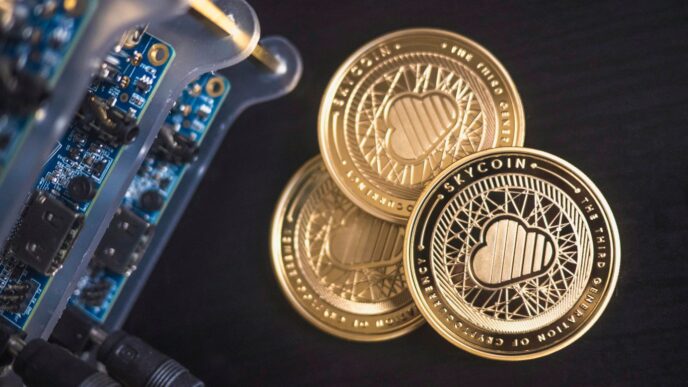Thinking about getting into crypto mining in 2025? It’s not quite like it used to be, where you could just fire up your old laptop. Today, you really need the right gear. Picking a good crypto mining machine is a big deal because it can make or break your operation. There are tons of options out there, and figuring out which one is best for you can feel overwhelming. This guide is here to help you sort through the noise and find a crypto mining machine that works.
Key Takeaways
- When looking at a crypto mining machine, pay close attention to its hash rate, which shows how fast it works, and its energy efficiency, which directly impacts how much you earn.
- Don’t just look at the price tag; figure out the real cost by considering electricity usage, potential earnings, and how long the machine will last.
- For businesses, balancing the initial cost of a crypto mining machine with its long-term efficiency and maintenance needs is super important for staying profitable.
- Popular crypto mining machine models in 2025 include options from Bitmain (Antminer), MicroBT (Whatsminer), and Canaan (Avalon).
- Setting up your mining operation involves choosing the right hardware, getting the software set up, and joining a mining pool for better results.
Understanding The Core Components Of A Crypto Mining Machine
So, you’re looking to get into crypto mining, huh? It’s not quite like plugging in a toaster, you know. These machines, often called ASICs (Application-Specific Integrated Circuits), are specialized pieces of kit designed for one job: mining. To figure out if a particular machine is any good, you need to look at a few key things. It’s not just about how fast it is; there’s more to it than that.
Hash Rate: Speed And Power
First up, let’s talk about the hash rate. Think of this as the engine size of your mining rig. It tells you how many calculations, or "hashes," the machine can churn out every second. We usually measure this in terahashes per second (TH/s) or even petahashes per second (PH/s) for the really powerful ones. The higher the hash rate, the better your chances of solving a block and earning those sweet crypto rewards. It’s pretty straightforward – more power means more potential earnings, assuming everything else is equal.
Energy Efficiency: The Key To Profitability
Now, this is where things get really interesting, and honestly, where a lot of people trip up. A machine might have a killer hash rate, but if it’s guzzling electricity like there’s no tomorrow, your profits will disappear faster than free donuts at a meeting. Energy efficiency is measured in joules per terahash (J/TH). A lower number here is what you want. It means the machine does more work using less power. It’s the difference between making a decent profit and just paying your electricity bill.
Here’s a quick look at how efficiency can stack up:
| Miner Model (Example) | Hash Rate (TH/s) | Power Consumption (Watts) | Efficiency (J/TH) |
|---|---|---|---|
| Older Model | 50 | 3000 | 60 |
| Mid-Range Model | 100 | 3200 | 32 |
| High-End Model | 150 | 3300 | 22 |
See the difference? That high-end model is doing way more work for less energy per hash.
Durability And Build Quality: Ensuring Longevity
These mining machines are not designed for a gentle life. They run 24/7, often in less-than-ideal conditions, generating a lot of heat and noise. So, how well it’s built really matters. You want a machine that’s made with solid components and has a good cooling system. If a rig is constantly overheating or breaking down, you’re looking at downtime, repair costs, and lost mining time. That’s bad for business. Think about:
- Cooling Systems: Active cooling with good fans is a must. Some higher-end models might even have liquid cooling options.
- Component Quality: Look for reputable manufacturers who use reliable parts. Cheaper components might save money upfront but cost you more in the long run.
- Noise Levels: While not directly impacting performance, extremely loud machines can be a nuisance and might require extra soundproofing, adding to your setup costs.
Key Factors To Consider Before Buying Your Next Crypto Mining Machine
So, you’re looking to buy a new mining machine, huh? It’s not as simple as just picking the one with the biggest number on the box. There’s a bit more to it if you actually want to make some money.
Calculating Profitability Beyond The Sticker Price
That shiny new miner might look like a good deal at first glance, but the price tag is only part of the story. You really need to crunch some numbers. Think about how much electricity costs where you live – that’s a big one. Then, figure out how much power the machine itself uses. Don’t forget about the network difficulty, which changes all the time, and the current price of the crypto you’re mining. A cheaper machine that guzzles electricity can end up costing you more in the long run than a slightly pricier but more efficient one. Seriously, use an online calculator to get a rough idea before you hand over your cash.
The Hash Rate Versus Efficiency Balance
Newer machines often brag about their super high hash rates, which is basically how fast they can do the math. But, the fastest machine isn’t always the most profitable one for you. It’s about finding that sweet spot. If you have access to really cheap electricity, maybe a high-hash-rate machine that uses a bit more power makes sense. But if your electricity bills are high, you absolutely need to focus on machines that are super energy-efficient. It’s a trade-off, and you need to figure out which side of the scale tips in your favor.
Reliability And Manufacturer Support
Imagine buying a miner, setting it all up, and then it breaks down a week later. That’s a nightmare scenario. You want a machine that’s built to last and run 24/7. Choosing a miner from a company known for making reliable equipment is super important. Also, think about what happens if something does go wrong. Does the manufacturer offer good customer support? Is there a warranty? Getting help when you need it can save you a lot of headaches and lost profits.
Choosing The Right Crypto Mining Rigs For Businesses
When you’re running a business, picking the right crypto mining hardware isn’t just about getting the most powerful machine. It’s a balancing act, really. You’ve got to think about how much electricity it’s going to chew through, how much it costs to buy in the first place, and if it’s going to break down on you after a few months. For businesses, these things add up fast.
Balancing Upfront Costs With Efficiency
Look, nobody wants to spend a fortune on equipment right out of the gate. But sometimes, paying a bit more for a rig that sips power can save you a ton of cash down the road. Think about it: mining rigs run all day, every day. That electricity bill can get pretty hefty. So, while a cheaper machine might seem tempting, if it’s an energy hog, you’ll likely end up paying more in the long run. It’s about finding that sweet spot where the initial investment makes sense with its ongoing running costs. Some rigs, like certain models from Bitmain, are known for their good balance of hash power and energy use, which is great for keeping those operational expenses in check.
Electricity Costs And Power Consumption
This is a big one for businesses. Electricity is probably your biggest operating expense when it comes to mining. You need to look at the power consumption of a rig (measured in watts) and compare it to its hash rate (how fast it mines). A rig that gives you a lot of hashing power for less electricity is usually the winner. For example, a machine with a high hash rate but also a sky-high power draw might not be as profitable as a slightly slower one that uses significantly less power. It really depends on what you’re paying for electricity in your area. Some businesses even look into setting up their own power generation to cut costs, but that’s a whole other ballgame.
Maintenance Requirements And Scalability
Nobody wants their expensive mining gear to break down. That means looking at the build quality and how well the machine is designed to handle running 24/7. Rigs with good cooling systems tend to last longer and have fewer issues. Also, think about the future. Can you easily add more machines if things go well? A modular setup, where you can just plug in more units, is way better than having to overhaul your entire system. This allows your business to grow gradually without massive disruptions. It’s about building a mining operation that can adapt and expand as your business goals evolve.
Top Crypto Mining Machine Models For 2025
Alright, so you’re looking to get into mining, or maybe upgrade your current setup for 2025. That’s smart. The market moves fast, and picking the right hardware can seriously make or break your profits. It’s not just about grabbing the first shiny box you see; you’ve got to think about what’s actually going to keep churning out coins without costing you a fortune in electricity.
Let’s talk about some of the big players and what they’re bringing to the table this year. These are the machines that are getting a lot of buzz for their performance and efficiency.
Bitmain Antminer Series
Bitmain’s Antminer line is practically a household name in the mining world. They’ve consistently put out some of the most powerful machines, and 2025 is no different. You’ll see models like the Antminer S21 Pro, which is a beast when it comes to air-cooled mining, pushing out a serious amount of hashes. Then there’s the S21 XP Hydro, which uses a water-cooling system. Water cooling can be a bit more complex to set up, but it often means you can push the hardware harder and keep it running cooler for longer, which is a big deal for keeping things profitable.
- Antminer S21 Pro: Great for those who want top-tier air-cooled performance. Expect high hash rates, but keep an eye on that power draw.
- Antminer S21 XP Hydro: If you’re ready for a more involved cooling setup, this one offers potentially higher performance and better thermal management.
- Antminer S19j Pro / S19k Pro: These are still solid, reliable options, maybe a bit older but often more accessible and still capable, especially if you find a good deal.
MicroBT Whatsminer Series
MicroBT is another major manufacturer that gives Bitmain a real run for its money. Their Whatsminer series is known for being pretty robust and reliable. The M60S and M66S models are definitely worth looking at. Some of these are designed for immersion cooling, which is similar to the Antminer Hydro – it’s a more advanced setup but can lead to better efficiency and longer machine life because the heat is managed so effectively. These machines are often praised for their build quality, meaning they can handle the constant grind of mining without giving you too much trouble.
- Whatsminer M60S: A strong contender in the air-cooled space, offering a good balance of power and efficiency.
- Whatsminer M66S (and Immersion variants): For those looking at advanced cooling solutions, these offer excellent thermal control and potentially higher sustained performance.
- Whatsminer M30S++: An older but still very capable model, known for its durability.
Canaan Avalon Miners
Canaan’s AvalonMiner series has also carved out a significant niche. They often focus on providing a good mix of performance and value. The Avalon A1566 is a model you’ll see mentioned, and like others, it comes in both standard and immersion-cooled versions. Avalon miners are sometimes seen as a more budget-friendly entry point, especially if you’re not aiming for the absolute bleeding edge of hash rates but still want a reliable machine. They’re built to last, which is always a plus when you’re running equipment 24/7.
- Avalon A1566: A solid performer that balances hash rate with energy use.
- Immersion-cooled Avalon models: Offer enhanced cooling for more consistent operation.
- Older Avalon models: Can be a cost-effective way to start mining if your budget is tighter.
When you’re looking at these, remember to check the latest specs for hash rate (TH/s) and energy efficiency (J/TH). The numbers change, and what’s top-tier today might be mid-range next year. Always do your homework on current electricity costs in your area, too, because that’s a huge part of the equation.
Setting Up Your Crypto Mining Operation

Alright, so you’ve picked out your mining rig – nice! Now comes the part where you actually get it running. It’s not super complicated, but there are a few things to get right so you don’t waste time or, worse, your electricity.
Selecting Appropriate Hardware
This is where you make sure your shiny new machine is actually going to work with everything else. You’ve probably already thought about the hash rate and power draw when you bought it, but double-check that your power supply can handle it. Seriously, don’t skimp here; you don’t want to trip breakers. Also, think about noise and heat. These things can get loud and hot, so plan where you’ll put them. Some folks even need extra cooling systems, especially if they’re running a bunch of machines. It’s all about making sure the hardware is set up for success from the get-go.
Installing And Configuring Mining Software
Once the hardware is physically set up, you need the software to tell it what to do. You’ll want to download the mining software from the official source – nobody wants a virus messing with their operation. After installation, you’ll need to configure it. This usually means plugging in the details for the mining pool you’ve chosen (more on that in a sec) and telling it where to send your earnings – that’s your wallet address. Most software lets you tweak settings, like fan speeds, to keep things running smoothly. Making sure your firewall isn’t blocking the software is a common hiccup, so keep that in mind.
Joining A Mining Pool And Wallet Setup
Solo mining is pretty much a long shot these days, so joining a mining pool is the way to go for most people. A pool combines your machine’s power with others, meaning you get smaller, more regular payouts instead of waiting forever for a big win. When picking a pool, look at their fees and how often they pay out. You’ll need to set up an account with the pool and create ‘workers’ – basically, names for your mining devices. For your wallet, you need a secure place to store your crypto. Hardware wallets are super secure for long-term storage, but software wallets are easier for everyday use. Just make sure whatever you choose is from a reputable provider, like Ledger or Trezor for hardware options. Getting your wallet set up correctly is key to actually receiving your mined coins. If you’re just starting out with altcoins, this guide can help you get a handle on the basics of mining altcoins.
Building A Future-Proof Mining Operation
The crypto mining landscape changes fast, and what’s profitable today might not be tomorrow. To keep your operation running smoothly and making money, you’ve got to think ahead. It’s not just about buying the latest gear; it’s about making smart choices that will pay off down the line. The key is to invest in hardware that’s not only powerful now but also efficient enough to stay competitive as mining difficulty goes up.
Staying Competitive With Evolving Difficulty
Mining difficulty is always on the rise. This means the machines you use need to keep up. If your hardware isn’t efficient, your electricity costs will eat into your profits faster than you can mine coins. It’s a constant race to stay ahead. You need to look at the long game, not just the immediate returns. This means keeping an eye on the network’s difficulty adjustments and how your current setup will fare.
Investing In Efficient And Durable Hardware
When you’re picking out new mining rigs, don’t just look at the hash rate. Energy efficiency, measured in joules per terahash (J/TH), is super important. A lower number means less power used for the same amount of work, which directly impacts your bottom line. Also, think about how long the machine will last. Mining hardware works hard 24/7, so build quality and good cooling systems are vital to avoid breakdowns and keep your uptime high. Machines like the Bitmain Antminer S19 Pro are often cited for their balance of performance and efficiency, but always check the latest models and reviews.
Partnering For Strategic Insight
Sometimes, you need a little help to see the whole picture. Working with experienced providers can give you access to the newest tech and advice on how to best manage your mining setup. They can help you understand market trends and make informed decisions about upgrades or new investments. This kind of partnership can make a big difference in keeping your operation profitable and ready for whatever comes next in the crypto world.
Wrapping Up Your Mining Machine Choice
So, picking the right crypto mining machine in 2025 really comes down to a few key things. It’s not just about grabbing the newest, flashiest box. You’ve got to think about how much power it uses, how fast it can crunch numbers, and if it’s built to last. Don’t forget to factor in your electricity costs – that’s a big one. Doing a bit of homework on different models, like the Antminers or Whatsminers, and comparing their specs will help a lot. Ultimately, the best machine for you is the one that fits your budget and your specific setup, helping you mine smarter, not just harder. Good luck out there!
Frequently Asked Questions
What is a crypto mining machine?
A crypto mining machine, often called an ASIC miner, is a special computer built just to solve hard math problems. Solving these problems helps keep the cryptocurrency network safe and running. When the machine solves a problem, you get a reward in cryptocurrency, like Bitcoin. Think of it as a super-fast calculator designed for one job: mining digital coins.
What does ‘hash rate’ mean for a mining machine?
Hash rate is like the speed of the mining machine. It tells you how many calculations, or ‘hashes,’ the machine can do every second. A higher hash rate means the machine is faster and has a better chance of finding the next block and earning a reward. It’s measured in things like terahashes per second (TH/s).
Why is energy efficiency so important for miners?
Mining machines use a lot of electricity, which costs money. Energy efficiency tells you how much power the machine uses to do its job. A more efficient machine uses less electricity for the same amount of work, meaning you spend less on power bills. This is super important because it directly affects how much profit you can make.
How do I know if a mining machine will be profitable?
To figure out if a machine is profitable, you need to look at more than just its price. You have to consider how much electricity it uses (and how much that costs where you live), how fast it is (its hash rate), and the current price of the cryptocurrency you’re mining. Online calculators can help you estimate your potential earnings and costs.
What’s the difference between hash rate and energy efficiency?
Think of hash rate as how fast the machine works, and energy efficiency as how much power it uses while working fast. A machine with a very high hash rate might be super fast but could also use a ton of electricity. A machine with great energy efficiency uses less power, which saves you money on electricity. You usually need to find a good balance between the two.
Should businesses use the same mining machines as individuals?
Businesses often need machines that are very efficient and reliable because they might be mining on a larger scale. They also have to think carefully about electricity costs and how to grow their operation over time. While some machines work well for both, businesses might lean towards models that offer the best long-term value and can handle continuous, heavy use.














